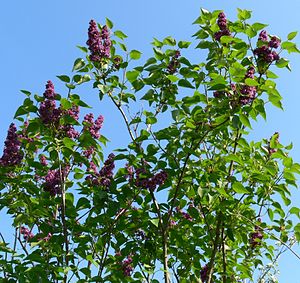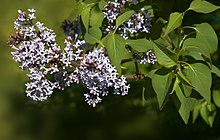lilac
| lilac | ||||||||||||
|---|---|---|---|---|---|---|---|---|---|---|---|---|

Common lilac (Syringa vulgaris hybrid) |
||||||||||||
| Systematics | ||||||||||||
|
||||||||||||
| Scientific name | ||||||||||||
| Syringa | ||||||||||||
| L. |
Lilac ( Syringa ) is a genus of plants from the olive family (Oleaceae). It includes around 20 to 25 species . They are mainly found in Asia as well as in Southeast Europe. The common lilac ( Syringa vulgaris ) is often planted as an ornamental shrub. The lilac is not related to the smaller summer lilacs from the fig family, which are also used as ornamental shrubs .
description
The representatives of this genus grow as deciduous shrubs or small trees. The branches are sometimes four-winged. The opposite, mostly stalked leaves of most lilac species are simple, rarely pinnate; For example, pinnate- shaped leaves have Syringa laciniata and Syringa pinnatifolia .
Many flowers are grouped together in often conspicuous, differently structured inflorescences . Most species and varieties bloom from May to June. The hermaphroditic, radial symmetry flowers are fourfold. The flowers of the lilac species and varieties come in many colors from dark purple to purple-red to yellow or white and usually spread a strong scent . The four sepals are fused bell-shaped. The four petals are also fused. There are only two stamens . The ovary is on top. The stylus is shorter than the stamens.
Little-seeded capsule fruits are formed. The seeds are winged.
distribution
The lilac species are native to Asia and Europe. There are localities for the following countries and regions: Afghanistan , India , Japan , Kashmir , Korea , Nepal , Pakistan , Sikkim (India), Southwest Asia and Southeast Europe . 16 different species grow in China alone. The common lilac ( Syringa vulgaris ) and the Hungarian lilac ( Syringa josikaea ) occur in southeastern Europe .






Systematics
The genus Syringa belongs to the tribe Oleeae in the family of Oleaceae . Synonyms for Syringa L. are: Busbeckia Hécart nom. inval., Ligustrina Rupr. , Lilac Mill. , Lilaca Raf. orth. var., Liliacum P. Renault nom. inval.
There are about 12 to 25 species in the genus lilac ( Syringa ):
- Himalayan lilac ( Syringa emodi Wall. Ex Royle , Syn .: Syringa tibetica P.Y. Pai ): Native to Pakistan up to the Himalayas and Tibet.
- Hungarian lilac ( Syringa josikaea J.Jacq. Ex Rchb. ): Native to Romania and the Ukraine.
- Komarov's lilacs ( Syringa komarowii C.K. Schneider ; including Syringa reflexa C.K. Schneider ): Native to China.
-
Round-leaved lilac ( Syringa oblata Lindl. ): With two subspecies:
- Syringa oblata subsp. dilatata (Nakai) PSGreen & MCChang : It occurs from northeast China to Korea.
- Syringa oblata subsp. oblata : It occurs in northern and central China.
- Syringa persica L. (Syn .: Syringa afghanica C.K. Schneider , Syringa laciniata (L.) Miller , Lilac minor Moench , Syringa angustifolia Salisb. , Syringa protolaciniata P.S. Green & MCChang ): The range extends from Afghanistan to the western Himalayas and from Qinghai to Gansu in China.
- Syringa pinetorum W.W.Smith (Syn .: Syringa mairei (H.Léveillé) Rehder , Syringa wardii W.W.Smith ): Native to China (Xizang, Sichuan, Yunnan).
- Feather-leaved lilac ( Syringa pinnatifolia Hemsley ): Native to northern and central China.
-
Woolly lilac ( Syringa pubescens Turczaninow , Syn .: Syringa meyeri C.K. Schneider ): With three or four subspecies:
- Syringa pubescens subsp. microphylla (Diels) MCChang & XLChen : It occurs in northern and central China.
- Syringa pubescens subsp. patula (Palib.) MCChang & XLChen : It occurs from northeast China to Korea.
- Syringa pubescens subsp. pubescens : It occurs from northern China to Henan.
-
Japanese lilac ( Syringa reticulata (Blume) H.Hara ): With three subspecies: Native to China, Korea, Japan, Russia and Mongolia.
- Syringa reticulata subsp. amurensis (Rupr.) PSGreen & MCChang : It occurs from Far Eastern Russia to Korea.
- Syringa reticulata subsp. pekinensis (Rupr.) PSGreen & MCChang : It occurs in northern and central China.
- Syringa reticulata subsp. reticulata : It occurs from the southern Kuril Islands to Japan.
-
Felted lilac ( Syringa tomentella Bureau & Franchet ): With three subspecies:
- Syringa tomentella subsp. sweginzowii (Koehne & Lingelsh.) Jin Y.Chen & DYHong (Syn .: Syringa sweginzowii Koehne & Lingelsheim ): It occurs from southeastern Tibet to western Sichuan.
- Syringa tomentella subsp. tomentella : It occurs in western Sichuan.
- Yunnan lilacs ( Syringa tomentella subsp. Yunnanensis (Franch) Jin Y.Chen & DYHong. , Syn .: Syringa yunnanensis Franchet ): It comes from southeastern Tibet to the southwestern Sichuan and northwestern Yunnan ago.
-
Shaggy lilac ( Syringa villosa Vahl ): With two subspecies:
- Syringa villosa subsp. villosa : It occurs in northern China.
- Wolf lilacs ( Syringa villosa . Subsp wolfii . (CKSchneid) Jin Y.Chen & DYHong ; Syn .: Syringa wolfii C.K.Schneider ): It occurs from southern far eastern Russia to Korea.
- Common lilac or common lilac ( Syringa vulgaris L. ): Native to Albania, the former Yugoslavia, Bulgaria, Greece and Romania.
There are also some hybrids:
- Chinese lilac or king lilac ( Syringa × chinensis Willd. ), Hybrid of Syringa vulgaris × Syringa persica
- Canadian lilac ( Syringa × prestoniae Elinor ), hybrid of Syringa komarowii subsp. reflexa × Syringa villosa
use

The common lilac in particular, but also varieties of other species and hybrids, are used as ornamental shrubs in parks and gardens. Some varieties are used as cut flowers. In Germany, the lilac blossom often adorns export trucks and shirts at men 's day parties on Father's Day .
In dry climates, for example, hornets and wasps gnaw on the bark of lilac branches in order to be able to absorb the sap.
swell
- Mei-chen Chang, Lien-ching Chiu, Zhi Wei & Peter S. Green: Oleaceae in der Flora of China , Volume 15, 1996, p. 280: Syringa - Online. (Section description)
- Fritz Grohmann: Oleaceae in the Flora of Pakistan : Syringa - Online. (Section description)
Individual evidence
- ↑ a b c d e f g Syringa in the Germplasm Resources Information Network (GRIN), USDA , ARS , National Genetic Resources Program. National Germplasm Resources Laboratory, Beltsville, Maryland.
- ↑ a b c d e f g h i j k l m n o p q Rafaël Govaerts (Ed.): Syringa. In: World Checklist of Selected Plant Families (WCSP) - The Board of Trustees of the Royal Botanic Gardens, Kew . Retrieved November 29, 2018.
- ^ Hornet (Vespa crabro) - The Phenomenon - Hornets in the Lilac Bush , Action Wasp Protection, September 5, 2011, accessed on August 16, 2018
- ↑ Folkert Siemens: Why hornets “ring” the lilac , My beautiful garden, accessed on August 16, 2018

